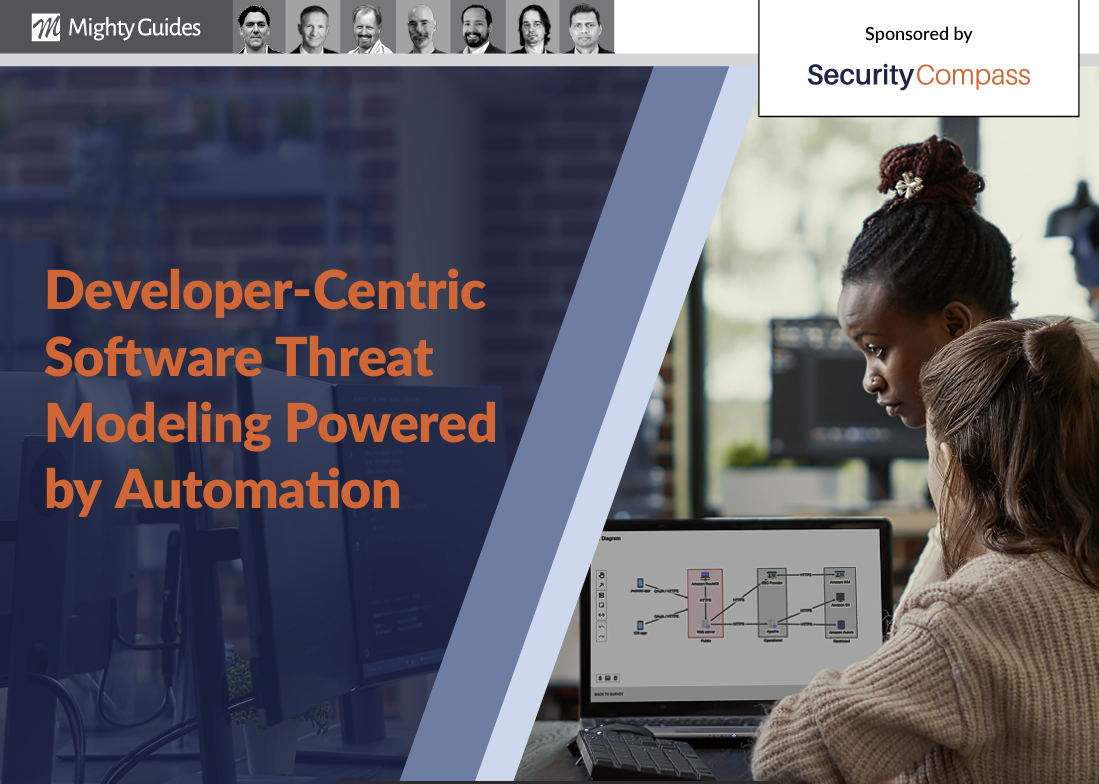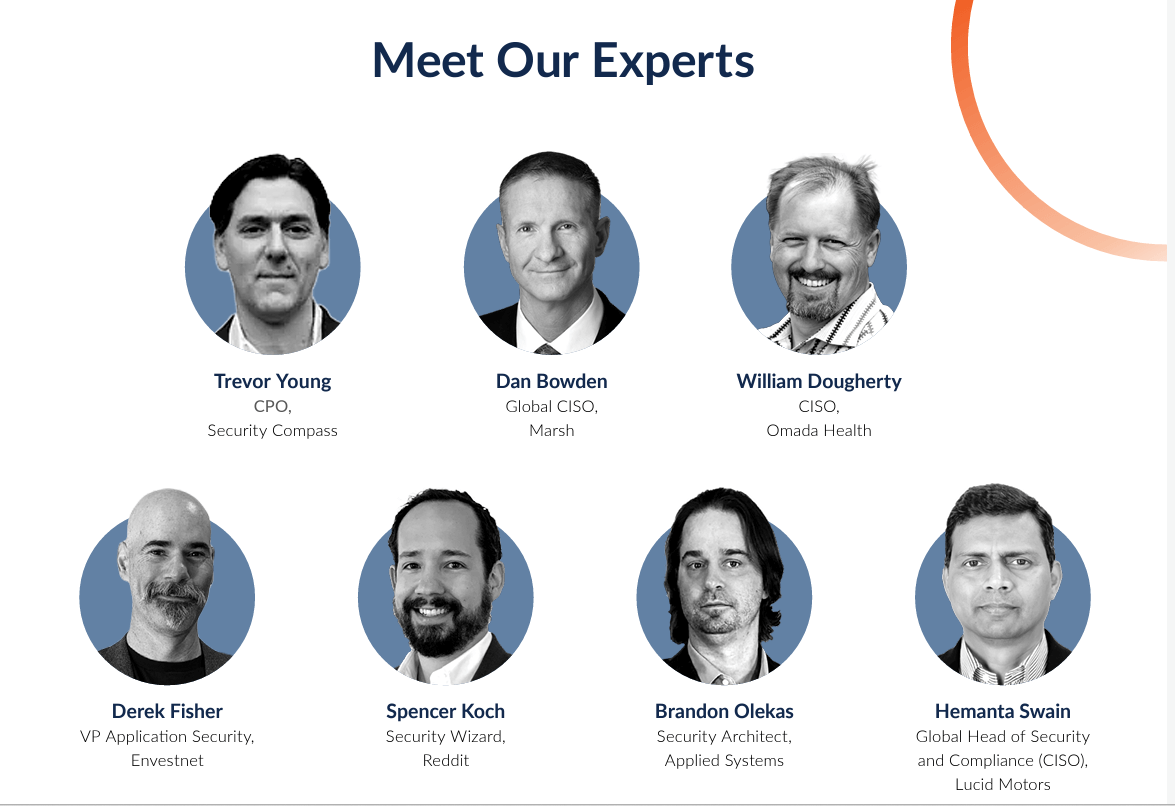Introduction
Legacy software threat modeling, as an exclusive security design activity, isn’t scaling well for today’s organizations. For a myriad of reasons, it doesn’t offer enough cross-functional analysis, provide enough prescriptive countermeasures, or even include enough of the system to truly identify and resolve threats. Legacy threat modeling misses critical areas relevant to the business, like risk, privacy, and compliance, and focuses too much on solving technical problems without understanding the context—so teams struggle to prevent the same issues in the future.
Today’s businesses and those of tomorrow, require an evolved, developer-centric threat modeling process powered by automation for real-time results. This type of threat modeling offers a holistic approach—from analysis to operational mitigation—educating teams throughout the organization on potential threats, resolving those threats, and preventing those threats in the future.
In this eBook, we focus on the current challenges with legacy threat modeling and why developer-centric threat modeling is critical for today’s businesses.
Foreword
In the era of DevOps, microservices, cloud, and a rapidly evolving software threat landscape, legacy approaches to software threat modeling, secure development, and compliance fail to meet the needs of software development and application security teams. Shifting left and building security and compliance into the software from the start is critical to increasing trust in digital infrastructure.
Using static and dynamic analysis testing tools that scan for security issues is a reactive, outdated approach to software security because it identifies security issues after they have already been coded. Fixing these vulnerabilities later in the development process results in higher remediation costs and delayed releases.
At Security Compass, we believe in developer-centric security: people, processes, and technologies focused on making security easy for developers to embed. This can be accomplished via relevant guidance during development and just-in-time training. It also enables teams to take a proactive “plan and prevent” approach to software threat modeling, security, and compliance rather than a reactive, “find and fix” approach.
With developer-centric software threat modeling, organizations can prevent breaches from happening in the first place. Proactively identifying and remediating software vulnerabilities before they become a problem significantly reduces software vulnerability remediation time, effort, risk, and cost.
Traditional Threat Modeling is Reactive, Expensive, and Limits Growth
Before we dive into the areas where traditional threat modeling is lacking, it’s important to agree on what traditional threat modeling looks like today.
Threat modeling is the most common process for evaluating, identifying,\ and mitigating the effects of cyber threats on a specific system, ideally during the design phase of software development (or, better yet, before a single line of code is written). This process can help identify relevant security requirements of a system as new components are built or maintained by a variety of teams. Threat modeling is often considered a critical part of secure software design and development.
“Traditional software threat modeling tends to focus more on threats, attackers, and breaches. While those are all valid, traditional threat modeling often misses the critical category of compliance.” -Trevor Young, CPO of Security Compass.
However, traditional software threat modeling presents several challenges. Those challenges show up in a few different ways.
Overburdened teams have too much to do
Already overburdened teams—whether they be application security teams, development teams, or software teams—are often tasked with threat modeling. Instead of reviewing every application in their software portfolio, teams are forced to focus only on critical assets, leaving gaps in coverage.
Plus, teams are overburdened with assessing their security posture. On average, organizations employ more than 75 security threat detection tools in their cybersecurity tech stack and receive more than 10,000 alerts each day from each service.1 This doesn’t just lead to too much information. It leads to a team being overburdened with too much information to adequately manage and use effectively
Compliance is deprioritized
When development teams or software teams are tasked with threat modeling, addressing compliance with well-known security standards is often deprioritized or not even considered as teams rush to meet timelines and beat deadlines. With time constraints and limited resources, compliance issues aren’t prioritized, leaving the organization open to compliance risk.
But just as expectations for software development have increased over the last 10 years, so has the importance of compliance. Data privacy regulations have grown more substantial, while government regulations have grown stricter. Missing this critical step in threat modeling doesn’t just put the organization at risk—it creates a ripple effect, and it can take weeks, months, or even longer to truly respond to a breach in terms of not just immediate customers but regulatory fees and other consequences for not following compliance rules.
No standardization across the organization
Legacy threat modeling processes make it difficult to compare the value of countermeasures across different teams because there is no standardization. Every department (and often every team) completes the task of threat modeling with varying degrees of detail and bias. Add in a variety of tools (up to 75!), overburdened teams that prioritize threat modeling and compliance to varying degrees, and siloed communication and standardization become a real challenge for organizations.
Altogether, time constraints, compliance issues, and consistency challenges make legacy threat modeling reactive, expensive, and limiting as businesses try to scale and stay safe.
Key Points
- Consistency in threat modeling is key—both consistency in the way you determine threats and consistency in recommending countermeasures.
- Legacy threat modeling creates more problems than it solves by asking overburdened teams to keep up with overflowing backlogs of security requirements, react to high-risk threats when they show up in production, and spend less time on development projects that can help the organization grow.
Modern Companies Need a Holistic, Developer-Centric Threat Modeling Platform
Organizations need a holistic, developer-centric threat modeling platform to take them to the next stage of maturity. But what differentiates a developer-centric threat modeling platform from more traditional threat modeling tools? Instead of focusing on reactive break-and-fix processes, which fail to asses an organization’s security across each department consistently and miss major compliance issues, a holistic developer-centric threat modeling platform offers a solution that covers the entire process—from analysis to implementation to measurement and reporting. It goes beyond technical countermeasures for security to also cover compliance, privacy, engineering, and operations, enabling an organization to achieve a defensive position early and often.
“The faster you move, the greater the risk of vulnerabilities being overlooked. And if you’re a company that’s on a rocket ship, meaning you have a lot of PR attention, and you suffer a privacy breach, that PR can take you down just as fast as it helped build you up. It’s important for fast-growing companies to be on top of threat modeling before it’s too late. It can reverse their momentum really quickly. “–Trevor Young, Chief Product Officer, Security Compass.
Legacy threat modeling often looks at system design only to assess threats. But in today’s technology environment, it’s critical for a holistic threat modeling platform to take a developer-centric approach to threat modeling and analyze all of the tech components, down to the programming languages and frameworks already in use or to be used. A holistic threat modeling platform accounts for all of it.
As organizations evaluate possible holistic threat modeling solutions, a few criteria are critical: • Automatically generating threat modeling diagrams • Identifying required threat countermeasures and security controls • Ensuring developers implement the required controls • Measuring the effectiveness of the program • Maintaining audit trails and data • Understanding a change in risk profile
Fast-growing companies need a holistic developer-centric threat modeling platform because security and compliance are often deprioritized when moving fast. However, a security breach can take the company down just as fast as it went up—a very serious reverse in momentum.
Traditional threat modeling solutions fall short because development teams need to spend a lot of time sorting through security requirements and support tickets to try and secure the system. The problem with this process? Dev teams are overwhelmed with trying to manage all the security requirements and support tickets without enough knowledge. If the same vulnerability continues to show up, there should be some repeated learning on how to not just get the vulnerability fixed but prevent it from happening again in the future.
Plus, with the shift to agile development practices, teams need a solution that seamlessly integrates into their development processes instead of separating threat modeling as a siloed activity.
Key Points
A holistic, developer-centric threat modeling tool extends beyond traditional threat modeling by covering compliance, PCI, privacy, operations, and more. It’s critical for organizations as more and more information is stored in the cloud, more regulations are enforced, and more customer information needs to be protected.
Security and compliance are often areas that get deprioritized, especially for fast-growing companies. But when a breach occurs, the PR that helped the organization grow so quickly could also be the ticket to a quick halt.
Developer-Centric Threat Modeling Provides Actionable Guidance for Building Security into Products
In order for developer-centric threat modeling to provide actionable guidance for building security into products, it must be focused on three main priorities—scalability, collaboration, and continuous development.
Scalability
A scalable system is flexible enough to allow as few or as many systems to fall under assessment so that stakeholders can make informed decisions around a portfolio-level security posture. The only way to accomplish this task is to have a high degree of automation in various steps of the threat modeling process—from the assessment of systems and recommendations of security requirements through to the translation of actionable guidance that teams on the ground (i.e., application development, DevOps) can use. It also needs to be highly integrated into other security workflow tools, such as issue trackers, code scanners, orchestration tools, and GRC systems.
Collaboration
A collaborative system will break down the walls of the currently siloed scenario that is all too common today. Instead, the system will provide opportunities for all teams to collaborate, communicate, and connect.
Continuous development
The next-generation threat modeling platform must align and seamlessly fit into agile practices around continuous integration and delivery. Work items across the software delivery lifecycle are continually changing, especially in our cloud- and microservices-driven environments. If the threat modeling system isn’t embedded, any modeling effort quickly becomes outdated.
“If you’re a CTO or a CSO, your plan is really about where to focus your time and energy, particularly when you have constrained resources. Developer-centric threat modeling should help with this. The right solution should help you identify which platforms or internal systems are critical, which ones have the most exposure, and which applications don’t need immediate attention.” -Trevor Young, Chief Product Officer, Security Compass
Software (or application) threat modeling should also be targeted, and relevant threats should be identified based on context. As issues arise, information is given to the development team at the right time—but just enough info so it doesn’t create more noise. For example, providing a developer with a step-by-step list of how to implement a countermeasure is a highly desired scenario.
Developer-centric threat modeling can build a better security plan for development teams by helping them identify which systems are contextually relevant. The right threat modeling tool should assess all applications and platforms and identify which systems have the most vulnerabilities and which systems don’t need attention right now (and this information is best delivered in an automatically generated report).
Key Points
- Developer-centric threat modeling should be focused on three main priorities: scalability, collaboration, and continuous development. Without a solution that accounts for and focuses on all three categories, businesses can’t scale, they can’t help to break down internal silos, and they can’t build threat modeling that is relevant because the models become quickly outdated.
- Developer-centric threat modeling should help organizations save time by quickly (and automatically) identifying which systems are at the most risk. A preliminary assessment of all systems and platforms should generate a report that identifies which areas need immediate attention (those with the most vulnerabilities) and which areas can wait for more resources (those with the fewest vulnerabilities).
Developer-Centric Threat Modeling Provides Contextual Guidance, Not Just Threat Analysis, to DevOps Teams
Developer-centric threat modeling supports continuous compliance because it’s embedded and connected to all of the right processes and systems. Because of this integrated approach, developer-centric threat modeling can readily encompass security compliance as well.
“The typical compliance method is to do an audit at a specific point in time, generally on an annual basis. Immediately after that audit, things start to change, and you don’t know until the next year how far off compliance you really are. Instead, if you’re connected to the live components that are changing, you can continually analyze them and prevent any drift.” -Trevor Young, Chief Product Officer, Security Compass.
A typical compliance process might rely on an annual audit for verification. Unfortunately, this annual audit report is quickly outdated because it’s measuring a specific point in time. The report is not continually updated against system components that are continually changing.
But when your threat modeling system is connected to the telemetry from system components or the components that are changing, it prevents compliance drift. It offers a real-time view of the compliance of the system or specific function. Next-generation threat modeling not only recognizes the importance of real-time connection but also prioritizes it.
Developers can achieve continuous compliance with the right threat modeling solution if it is integrated into their development pipeline and utilizes the right level of automation. Trading out a long backlog of tasks to complete before an auditor arrives for continuous feedback creates more safety and security and less work for each team.
Key Points
- Continuous compliance can only be achieved if threat modeling tools are connected to the development pipelines of system components— which are constantly radiating relevant security information. Without this connection, the traditional method of an annual audit leaves the company at more risk— reducing the shelf life of a report to shortly after it has been presented.
- Threat modeling should be integrated into the development pipeline, not just viewed as an add-on. Without a truly integrated and embedded system, continuous compliance won’t scale.
Conclusion
It’s clear that legacy threat modeling presents real challenges for today’s businesses. Time constraints, budgets, and ever-growing compliance requirements create even more challenges for the threat modeling process organizations have been using for years. Developer-centric software threat modeling offers a path to improving the security of software products at a scale and speed aligned with today’s fast-moving, rapidly evolving, interconnected digital world. It not only identifies software security threats and provides countermeasures but also scales through automation, improves collaboration by providing contextual guidance, and consistently identifies threats by embedding them into current processes and systems to achieve continuous compliance.



